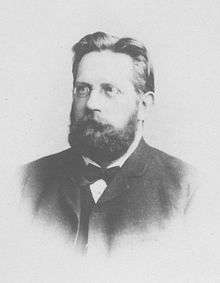Franz Martin Hilgendorf
| Franz Martin Hilgendorf | |
|---|---|
 | |
| Born |
5 December 1839 Neudamm (Mark Brandenburg), Germany (today Dębno, Poland) |
| Died |
5 July 1904 (aged 64) Berlin Germany |
| Nationality | German |
| Fields | zoologist and paleontologist |
| Known for | discovery of evolution in snails |
Franz Martin Hilgendorf (5 December 1839 – 5 July 1904) was a German zoologist and paleontologist. Hilgendorf's research on fossil snails from the Steinheim crater in the early 1860s became a palaeontological evidence for the theory of evolution published by Charles Darwin in 1859.
Life and work
Franz Hilgendorf was born on 5 December 1839 in Neudamm (Mark Brandenburg). Between 1851 and 1854 he went to a gymnasium in Königsberg (Neumark) and later to the Gymnasium Zum Grauen Kloster (Grey Monastery) in Berlin where he graduated in 1858. In 1859 he started studying philology at the University of Berlin. After four semesters he changed to the University of Tübingen. In the summer of 1862 he joined an excavation by Friedrich August Quenstedt in the Steinheim crater. In 1863 Hilgendorf received his Ph.D. for work related to this excavation. He finished his research on the fossils during his time at the Museum für Naturkunde in Berlin. in 1868 Hilgendorf became director of the aquarium of the Zoological Garden of Hamburg and in 1870 and 1871 he worked as librarian at the German Academy of Sciences Leopoldina. In 1873 Hilgendorf was appointed lecturer at the Imperial Medical Academy Tokyo. He stayed in Japan from 1873 till 1876 and published articles and collected several specimens of Japanese fauna. Hilgendorf returned to Germany with his collection and worked in the Museum für Naturkunde in Berlin. He was first responsible for the worms and snails section and from 1896 the fish section.
In 1890 Gustav Wilhelm Müller identified a new species of ostracod crustacean in the collection of Hilgendorf and named it Cypridina hilgendorfii.[1] This name changed to Vargula hilgendorfii in 1962. Another fish named after Hilgendorf is Helicolenus hilgendorfii of Japan, described in 1884 by Ludwig Döderlein.
Hilgendorf suffered from a gastric illness. He stopped working in 1903 and died from that illness on 5 July 1904.[1]
References
- 1 2 Yajima, M. (2007). "Franz Hilgendorf (1839–1904): introducer of evolutionary theory to Japan around 1873". Geological Society, Special Publications. 287: 389–393. doi:10.1144/SP287.28.
External links
- Alles über das Steinheimer Becken und einiges zu den Arbeiten Franz Hilgendorf`s (Everything on the Steinheim crater and a little bit on the work of Franz Hilgendorf)
- Website der Deutschen Gesellschaft für Natur- und Völkerkunde Ostasiens
- 140 Jahre Hilgendorfs Steinheimer Schnecken-Stammbaum: der älteste fossile Stammbaum aus heutiger Sicht (140 years of Hilgendorfs genealogical tree of Steinheimer Snails: the oldest genealogical tree of fossils seen from today)